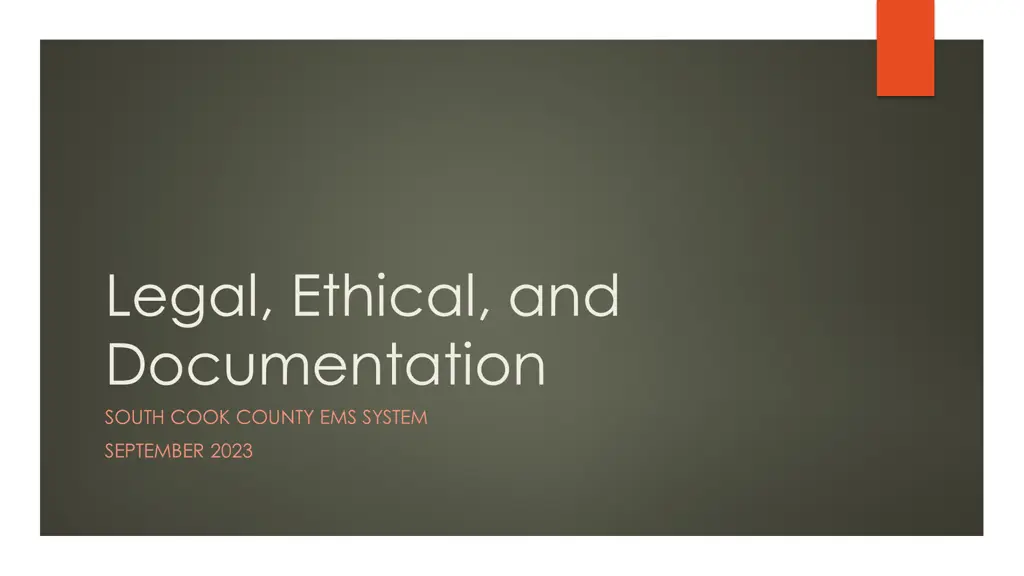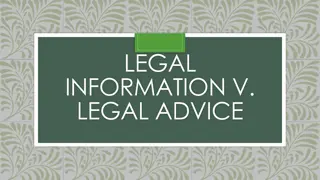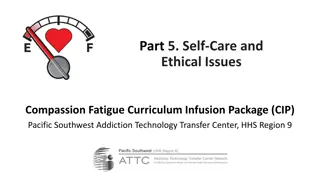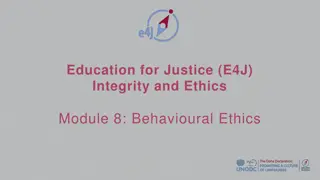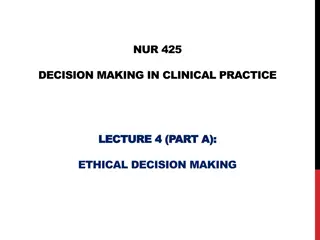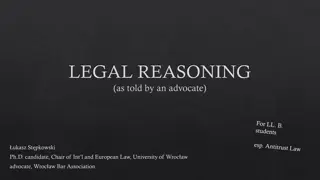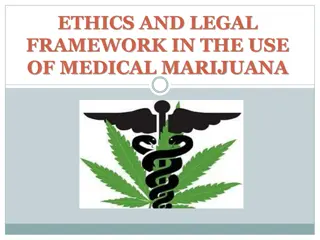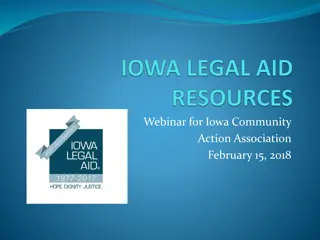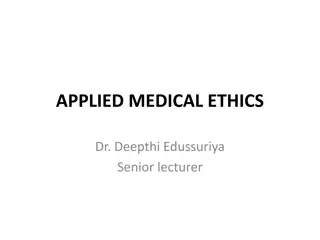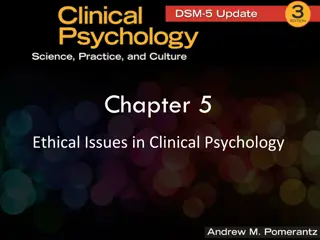Legal, Ethical, and Documentation
Explore legal and ethical duties in the South Cook County EMS System, distinguishing between legal and ethical responsibilities. Understand the importance of laws relevant to paramedics and consent issues like abandonment, assault, battery, slander, and libel.
Download Presentation

Please find below an Image/Link to download the presentation.
The content on the website is provided AS IS for your information and personal use only. It may not be sold, licensed, or shared on other websites without obtaining consent from the author. Download presentation by click this link. If you encounter any issues during the download, it is possible that the publisher has removed the file from their server.
E N D
Presentation Transcript
Legal, Ethical, and Documentation SOUTH COOK COUNTY EMS SYSTEM SEPTEMBER 2023
Objectives Distinguish legal from ethical responsibilities. Identify and explain the importance of laws relevant to the paramedic. Consent Define the following: Abandonment Assault Battery Duty to act
Objectives Define the following Slander Libel Ethics Discuss the concept of medical direction including offline and online and their relation to the standard of care for the paramedic. Discuss the different problems and conditions paramedics are required to report
Introduction Jurisprudence The theory and philosophy of law Legal duties Defined by statutes or written protocols that are based on accepted standards of care. The paramedic has a legal obligation to the patient, the medical director, and the public. Ethical duties of the Paramedic You must also uphold many ethical responsibilities. Ethics are moral principles based on societal standards that identify desirable conduct. In some cases ethics are considered stricter than law indicating a greater responsibility for the paramedic.
Terminology Abandonment Assault Threat of imminent bodily harm to another person with the obvious ability to carry out the threat. Battery Touching or making contact to another person without their consent. Defamation To cause or bring about false information that injures a persons character or reputation. Libel occurs as a written form and slander in a verbal form of defamation.
The legal system Paramedics like other healthcare providers must operate within the legal system which has many levels: Local System policies and regional SMO State EMS Systems Act (210 ILCS 50) Joint Committee for Administrative Regulations Title 77 Section 515 Federal Public Law 93-154 EMS Systems Act (EMSSA)
Liability and Negligence Liability the legal responsibility of a party for the consequences of his or her acts or omissions. Negligence The failure to act as a reasonably prudent and careful person would act under similar circumstances. Gross Negligence a heightened degree of negligence representing an extreme departure from the ordinary standard of care. Components of a negligence charge Duty to act Breach of duty Damages Causation
Components of negligence cont. Duty to act A paramedic must act with due regard for the patient and uphold the applicable standard of care. A paramedic who is employed and working (on duty) for an ambulance or other service provider that has been dispatched or requested to the scene of a medical emergency has a legal duty to act. To the contrary, a paramedic who is a passerby, off duty, and who was not summoned to the scene has no legal duty to act.
Components of negligence cont. Breach of duty The situation must find that the paramedic did not act in a reasonably prudent manner and follow the applicable standard of care. Damages Compensable harm caused by the neglect act. Causation Also known as proximate cause means that the negligence caused or created the harm.
Good Samaritan Act (745 ILCS 49/70) of the Good Samaritan Act identifies the following immunity from civil litigation: Any law enforcement officer or fireman as defined in Section 2 of the Line of Duty Compensation Act, any "emergency medical technician (EMT)" as defined in Section 3.50 of the Emergency Medical Services (EMS) Systems Act, and any "first responder" as defined in Section 3.60 of the Emergency Medical Services (EMS) Systems Act, who in good faith provides emergency care, including the administration of an opioid antagonist as defined in Section 5-23 of the Substance Use Disorder Act, without fee or compensation to any person shall not, as a result of his or her acts or omissions, except willful and wanton misconduct on the part of the person, in providing the care, be liable to a person to whom such care is provided for civil damages.
Consent A competent patient or legal representative is entitled to make decisions about the care they wish to receive or be given. Types of consent Expressed Consent that is given by a patient or a legal representative either verbal or physical expression of that consent. Implied This consent is presumed. A patient who is ill or injured and for any reason; unconsciounses, incapicated, or a minor that is unable to give consent, would consent to treatment for their condition. Involuntary Care given to a person under specific legal authority
Refusals of care A competent patient or legally responsible decision maker who is properly informed of the risks of not receiving treatment and the benefits of receiving treatment are permitted to refuse medical care and/or transportation. This includes life saving emergency care.
Refusals of care Minimum documentation A record of the patients mental status Findings of the patient assessment Details of the mechanism of injury or present illness Specific risks discussed with the patient and the patient understanding of those risks Medical Direction involvement, if applicable Signature of patient or legally responsible decision maker on a refusal of care form that includes a release of liability.
Refusals of care Instances may occur that involve the inability of EMS to make contact with the patient. When these instances occur, EMS needs to provide a clear understanding of the circumstances in the patient care report. These situations should involve communication with medical control and be outlined in the narrative of the patient care report.
Patient care reports State law requires that a patient care report be completed for a patient when EMS has been requested for a person that is ill or injured. Regardless of the ultimate outcome or disposition of the call. This law also states that a patient care report must be left at the destination facility prior to EMS returning in service. https://www.ilga.gov/commission/jcar/admincode/077/077005150C03500R.html
Medication of the quarter Tranexamic Acid (TXA)
Tranexamic Acid (TXA) An antifibrinolytic used to prevent blood loss in patients with a systolic blood pressure below 70 mmHg. This is outlined in Protocol 22 Adult Hemorrhagic Shock and does not need approval from medical control prior to use. Notify receiving facility as early as possible informing them of the medication on board. They need the to prepare for the arrival of the patient and the ability to continue the TXA treatment.
TXA Cont. To administer the medication: Draw 1g from vial and add to the 100mL 0.9 NS, roll gently to mix, do not shake. Mark bag with its contents Spike bag with macro drop tubing and administer medication IVPB over 10 minutes. 10 drop tubing rate: 5 drops every 3 seconds 20 drop tubing rate: 10 drops every 3 seconds
